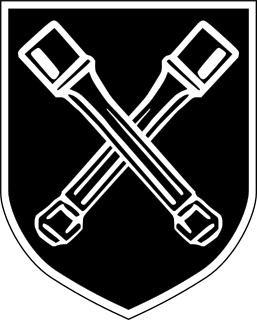 W
WThe 3rd Estonian SS Volunteer Brigade was a formation of the German Waffen-SS during World War II. It was formed in May 1943, when the Estonian SS Legion was upgraded. The first name chosen for the brigade was the Estonian SS Volunteer Brigade, until October 1943, when all SS brigades were numbered so it finally became the 3rd Estonian Volunteer Brigade. The brigade was expanded to a division and renamed on January 23, 1944.
 W
WThe Volunteer Legion Netherlands was a collaborationist military formation recruited in the German-occupied Netherlands during World War II. It was formed in the aftermath of the German invasion of the Soviet Union and fought on the Eastern Front in the Waffen SS alongside similar formations from other parts of German-occupied Western Europe. It was the largest Dutch SS unit.
 W
WThe Flemish Legion was a collaborationist military formation recruited among Dutch-speaking volunteers from German-occupied Belgium, notably from Flanders, during World War II. It was formed in the aftermath of the German invasion of the Soviet Union and fought on the Eastern Front in the Waffen SS alongside similar formations from other parts of German-occupied Western Europe.
 W
WThe French SS Volunteer Assault Brigade, most commonly known as the Brigade Frankreich was a unit of the Waffen-SS of Nazi Germany during World War II. It was formed in 1943 after a change in the admission standards of the Waffen-SS allowed Frenchmen to enlist for the first time. After training in Alsace, the brigade served on the Eastern Front before merging with the Legion of French Volunteers Against Bolshevism to form the SS Division Charlemagne.
 W
WThe Walloon Legion was a collaborationist military and security formation recruited among French-speaking volunteers from German-occupied Belgium, specifically from Brussels and Wallonia, during World War II. It was formed in the aftermath of the German invasion of the Soviet Union and fought on the Eastern Front as part of the German Army and later the Waffen-SS alongside similar formations from other parts of German-occupied Western Europe.
 W
WThe Volga-Tatar Legion or Legion Idel-Ural denoted a series of units within the Wehrmacht in World War II. It was recruited among Muslim Volga Tatar in the Soviet Union, but also included other Idel-Ural peoples such as Bashkirs, Chuvashes, Mari people, Tatars, Udmurt people, and Mordva.
 W
WKaminski Brigade, also known as Waffen-Sturm-Brigade der SS RONA, was a collaborationist formation composed of Soviet nationals from the territory of the Lokot Autonomy in Axis-occupied areas of the RSFSR in the Soviet Union during the German–Soviet War of 1941−45.
 W
WSchutzmannschaft-Brigade Siegling was a Belarusian Auxiliary Police brigade formed by Nazi Germany in July 1944 in East Prussia, from members of six local volunteer battalions of Schutzmannschaft following the Soviet Operation Bagration. The six retreating collaborationist units who joined Siegling included Bataillon 57 (ukrainische), Bataillon 60 (weißruthenische), Bataillon 61, 62, 63 (ukrainische), and Bataillon 64 (weißruthenische).
 W
WThe SS Cavalry Brigade (SS-Kavallerie-Brigade) was a unit of the German Waffen-SS during World War II. Operating under the control of the Kommandostab Reichsführer-SS, it initially performed rear security duties in German-occupied Poland. During the Invasion of the Soviet Union, the brigade operated in the rear of the German forces, in the Army Group Rear Area Command. It engaged bypassed Red Army units and murdered Jews, Communists, and so-called partisans. In 1942, the brigade was disbanded and its personnel was transferred to the newly formed SS Division Florian Geyer.
 W
WThe Dirlewanger Brigade, also known as the SS-Sturmbrigade Dirlewanger (1944), or the 36th Waffen Grenadier Division of the SS, or Black Hunters, was a unit of the Waffen-SS during World War II. The unit, named after its commander Oskar Dirlewanger, consisted of convicted criminals who were not expected by Nazi Germany to survive their service with the unit. Originally formed in 1940 and first deployed for counter-insurgency duties against the Polish resistance movement, the brigade saw service in anti-partisan actions in German-occupied Eastern Europe.